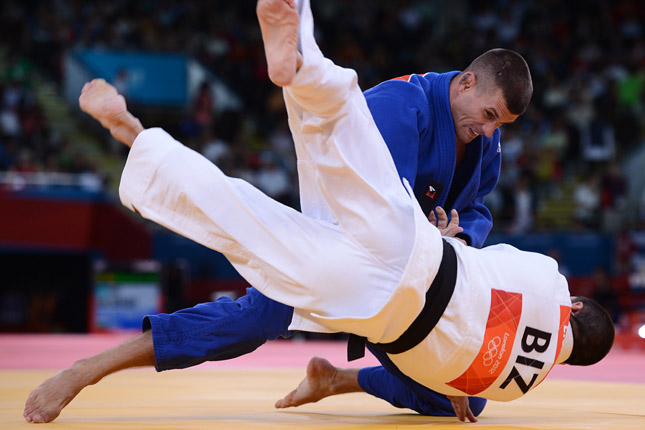International Judo Federation Contest Rules
International Judo Federation Contest Rules

KANO JIU JITSU Contest Rules
The Original Kodokan Judo Tournament Rules
H. Irving Hancock and Katsukuma Higashi, The Complete Kano Jiu-Jitsu (Judo),
(New York: Dover Publications, 1905)
1. Each contestant shall wear coat and belt.
2. A contestant shall be deemed to have been defeated when his two shoulders and hips shall have touched the floor, provided that said contestant shall have reached this position on the floor through having been thrown down.
3. A contestant shall be deemed to have been defeated when in such position on the floor, if said combatant cannot free himself from his opponent's arms within two seconds' time.
4. A contestant shall be deemed to have been defeated when from any cause or causes he may become unconscious. But it is not permitted to use serious tricks when the wrestling bout is between friends. Such tricks as kicking and the breaking of arms, legs, and neck are barred.
5. A combatant shall be deemed to have been defeated when he has been reduced to submission through the employment by his opponent of any hold or trick.
6. When a defeated combatant finds himself obliged to acknowledge his submission, he must pat or hit the floor or his antagonist's body, or somewhere, with his hand or foot. This patting with foot or hand is to be regarded as a token of surrender.
7. When a defeated combatant pats or hits the floor, or anywhere, in token of submission, the victor must at once let go his hold.
8. It is understood and agreed that the Jiu-Jitsu man, whether he fights a boxer or contests with a wrestler, shall be allowed to use in his defense any of the tricks that belong to the art of Jiu-Jitsu.
9. It is further understood and agreed that the Jiu-Jitsu man assumes no responsibility for any injury or injuries caused by any act or thing done during the contest, and that the Jiu-Jitsu man shall be held free and blameless for any such ill effect or injury that may be received during the contest.
10. Two competent witnesses representing each side, or four in all, shall see to it that these articles of agreement are properly drawn, signed, and witnessed, to the end that neither contestant or other participant in the match shall have cause for action on any ground or grounds resulting from any injury or injuries, or death, caused during the contest.
History of Contest Rules
The rules of JUDO contest have changed much since 1880’s. Draft of the contest rules written by the founder, Jigoro KANO for the first Red and White JUDO Tournament held in 1884. It was the first annual JUDO competition. This tournament is still held every year at the KODOKAN. Jigoro KANO had studied wrestling rules and had practical experience from JU-JUTSU matches so he developed a set of rules to guide the contest.
In 1899 in JU-JUTSU/JUDO contests locks of fingers, toes, wrists and ankles were banned.
In 1916, ASHI-GARAMI (twisting kneelock) and DO-JIME (trunk/kidney squeeze) were banned by the KODOKAN.
In 1925, joint lock attacks (KANSETSU-WAZA) were limited to the elbow.
Contest Rules of the Kodokan Judo were formulated and written in about 1948, with translation being officially made into English.
Originally judo matches had no time limit, then in the 1950's and 1960's the rules called for a maximum of 20 minutes, and in the 1970's the World Championship finals still lasted up to 15 minutes. However, as Judo became more and more popular match times had to be reduced to the current 5 minute limit.
Tokyo Olympics 3 weight categories (-68 kg, -80 kg, +80 kg) were introduced in addition to the open category. The categories were
After 1980 ALL-JAPAN CHAMPIONSHIP another safety rule adopted was the banning of KANI-BASAMI (flying scissors). Olympic gold medallist Yasuhiro YAMASHITA received a broken ankle from this technique.
In 1974 the smaller scores of YUKO and KOKA were added, and a penalty (SHIDO) for passivity was introduced for the first time to prevent stalling. In 2009 the KOKA score was eliminated.
In 1992 the open weight category was dropped from the Olympics so there are currently 7 weight categories for both men and women in the Olympics.
In 2000 the OSAE-KOMI(Pin) rules changed to award a win for a 25 second hold, the previous 30 seconds hold had been required.
The categories were expanded to 6 for the 1972 Olympics, and 8 for the 1980 Olympics. In 1988 the open category was dropped from the Olympics.
Today there are 7 WEIGHT CATEGORIes for both men and women in the OLYMPIC GAMES.
In 2003 rules were amended by the IJF Refereeing Commission to include a penalty for Kawazu Gake, creation of a Golden Score overtime, the simplification to only two types of penalties (Shido and Hansoku Make) instead of four (Shido, Chui, Keikoku, Hansoku Make), and new bowing procedures which were implemented in advance of the publication of the new rules.
If you want to know more about how the rules of Judo competition have evolved you might be interested in seeing these official International Judo Federation (IJF) rulebooks:
Sources:
Ohlenkamp, Neil. "Evolution of Judo Contest Rules." www.judoinfo.com
"The Judo Rank System -- Belts." www.judoinfo.com
"Original Kodokan Judo (Kano Jujitsu) Contest Rules." www.judoinfo.com
Kano, Jigoro. "Jujutsu Becomes Judo." www.judoinfo.com

